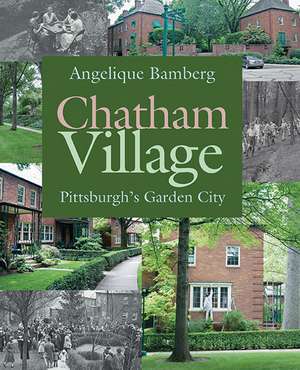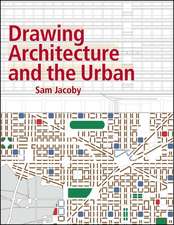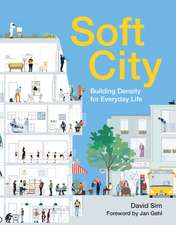Chatham Village: Pittsburgh's Garden City
Autor Angelique Bambergen Limba Engleză Paperback – 15 ian 2014
Chatham Village, located in the heart of Pittsburgh, is an urban oasis that combines Georgian colonial revival architecture with generous greenspaces, recreation facilities, surrounding woodlands, and many other elements that make living there a unique experience. Founded in 1932, it has gained international recognition as an outstanding example of the American Garden City planning movement and was named a National Historic Landmark in 2005.
Chatham Village was the brainchild of Charles F. Lewis, then director of the Buhl Foundation, a Pittsburgh-based charitable trust. Lewis sought an alternative to the substandard housing that plagued low-income families in the city. He hired the New York–based team of Clarence S. Stein and Henry Wright, followers of Ebenezer Howard’s utopian Garden City movement, which sought to combine the best of urban and suburban living environments by connecting individuals to each other and to nature.
Angelique Bamberg provides the first book-length study of Chatham Village, in which she establishes its historical significance to urban planning and reveals the complex development process, social significance, and breakthrough construction and landscaping techniques that shaped this idyllic community. She also relates the design of Chatham Village to the work of other pioneers in urban planning, including Frederick Law Olmsted Sr., landscape architect John Nolen, and the Regional Planning Association of America, and considers the different ways that Chatham Village and the later New Urbanist movement address a common set of issues. Above all, Bamberg finds that Chatham Village’s continued viability and vibrance confirms its distinction as a model for planned housing and urban-based community living.
Chatham Village was the brainchild of Charles F. Lewis, then director of the Buhl Foundation, a Pittsburgh-based charitable trust. Lewis sought an alternative to the substandard housing that plagued low-income families in the city. He hired the New York–based team of Clarence S. Stein and Henry Wright, followers of Ebenezer Howard’s utopian Garden City movement, which sought to combine the best of urban and suburban living environments by connecting individuals to each other and to nature.
Angelique Bamberg provides the first book-length study of Chatham Village, in which she establishes its historical significance to urban planning and reveals the complex development process, social significance, and breakthrough construction and landscaping techniques that shaped this idyllic community. She also relates the design of Chatham Village to the work of other pioneers in urban planning, including Frederick Law Olmsted Sr., landscape architect John Nolen, and the Regional Planning Association of America, and considers the different ways that Chatham Village and the later New Urbanist movement address a common set of issues. Above all, Bamberg finds that Chatham Village’s continued viability and vibrance confirms its distinction as a model for planned housing and urban-based community living.
Preț: 174.88 lei
Nou
Puncte Express: 262
Preț estimativ în valută:
33.46€ • 34.94$ • 27.70£
33.46€ • 34.94$ • 27.70£
Carte disponibilă
Livrare economică 15-29 martie
Preluare comenzi: 021 569.72.76
Specificații
ISBN-13: 9780822962786
ISBN-10: 0822962780
Pagini: 232
Ilustrații: 17 color, 67 b&w Illustrations
Dimensiuni: 178 x 229 x 13 mm
Greutate: 0.48 kg
Ediția:1
Editura: University of Pittsburgh Press
Colecția University of Pittsburgh Press
ISBN-10: 0822962780
Pagini: 232
Ilustrații: 17 color, 67 b&w Illustrations
Dimensiuni: 178 x 229 x 13 mm
Greutate: 0.48 kg
Ediția:1
Editura: University of Pittsburgh Press
Colecția University of Pittsburgh Press
Recenzii
“Chatham Village was a Depression-era model in community planning that has remained faithful to its founding mission while accommodating itself to rampant change. Angelique Bamberg provides a preservationist perspective on one of Pittsburgh’s many urban treasures while considering its meaning in relation to the New Urbanism of the early twenty-first century. Hers is a thoughtful, even-handed, and much-needed study.”
—Kenneth Kolson, The Ohio State University
—Kenneth Kolson, The Ohio State University
“Chatham Village was originally sponsored by the Buhl Foundation as an affordable and attractive white-collar enclave of Pittsburgh. It is still a cohesive, economical, and green community that remains relevant as an alternative to wasteful suburban sprawl. Bamberg has written a highly readable and informative study of this important early experiment in community planning for the automobile age.”
—Stanley Buder, Baruch College
—Stanley Buder, Baruch College
“The pleasures of ‘Chatham Village’ begin the moment you pick up the book. . . . Bamberg proves to be as knowledgeable and articulate on the page as she was in person, analyzing the merits of Pittsburgh buildings before the city’s Historic Review Commission. . . . Essential reading for today’s developers of public and private housing.”
—Pittsburgh Post-Gazette
—Pittsburgh Post-Gazette
“Handsomely illustrated and . . . illuminating.“
—H-Net Reviews
—H-Net Reviews
“Beautifully designed, well-illustrated, and carefully crafted . . . a beautiful and nicely written saga of what good planning and good management can accomplish in housing if all the stars—the vision, the resources, and the ideal circumstances—are aligned.”
—Pennsylvania Magazine of History & Biography
—Pennsylvania Magazine of History & Biography
Notă biografică
Angelique Bamberg is an independent consultant specializing in city planning and historic preservation and an instructor in the Department of the History of Art and Architecture at the University of Pittsburgh.
Descriere
Angelique Bamberg provides the first book-length study of the community of Chatham Village in Pittsburgh. She establishes its historical significance to urban planning and reveals the complex development process, social significance, and breakthrough construction and landscaping techniques that shaped this idyllic community.








